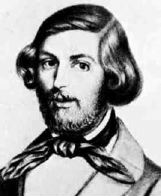

Gotthold Eisenstein suffered all his life from bad health, but at least he survived childhood which none of his 5 brothers and sisters succeeded in doing. His mother had a major role in
her son's early education. He also showed a considerable talent for music from a young age and he played the piano and composed music throughout his life.
When he was about 10, his parents sent him to Cauer Academy in Charlottenburg.
When he was 14 years old, Eisenstein entered the Friedrich Wilhelm Gymnasium to
complete his schooling. His mathematical talents were recognized by his teachers as soon as he entered the Gymnasium, and his teachers
gave him every encouragement. However, he soon went well beyond the school syllabus in mathematics, and from the age of 15 he was buying books to study on his own. He began by learning the differential and integral calculus from the works of Euler and Lagrange.
By the time he was 17, although he was still at school, he began to attend lectures by Dirichlet and other mathematicians at the University of Berlin. He became familiar with applied technology and science, which aroused his interest in mathematics even more. Hamilton gave him a copy of a paper that he had written on Abel's work, which further stimulated Eisenstein to begin research in mathematics.
Eisenstein enrolled at the University of Berlin in 1843, and the following year he submitted to the Berlin Academy a paper on cubic forms with two variables. He was working on a variety of topics at this time. Eisenstein published 23 papers and 2 problems in 1844. Even Gauss was impressed with his work.
Kummer and Jacobi arranged that the University of Breslaw award Eisenstein an honorary doctorate in 1845. In 1847 Eisenstein received his habilitation from the University of Berlin and began to lecture. Riemann attended lectures that he gave on elliptic functions that year.
Despite his health problems, Eisenstein published one treatise after another.
There are 3 major areas of mathematics to which Eisenstein contributed. He worked on the theory of forms and higher reciprocity laws, with the aim of generalizing Gauss's results in his Disquisitiones arithmeticae. He also made major contributions to the theory of elliptic functions.
He received many honours. For example, he was elected to the Göttingen Academy in 1851 and to the Berlin Academy in 1852. He died of pulmonary tuberculosis at the age of 29.